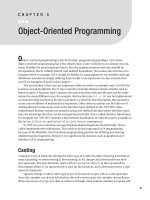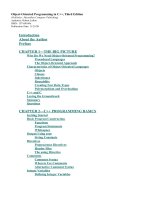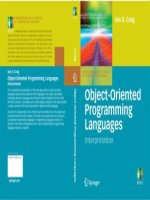Lecture Object oriented programming - Lecture No 16
Bạn đang xem bản rút gọn của tài liệu. Xem và tải ngay bản đầy đủ của tài liệu tại đây (139.3 KB, 23 trang )
CSC241: Object Oriented Programming
Lecture No 16
1
Previous lecture
•
Abstract class
•
Public and private Inheritance
–
•
Difference come when creating objects of derived
class
Level of inheritance
–
Object of class C can
access public member of
class B and A
class A
{ };
class B : public A
{ };
class C : public B
{ };
2
Today’s Lecture
•
Multiple inheritance
–
•
Example program: employ and student class
Constructor in multiple inheritance
–
Example program
•
Aggregation
•
Composition
3
Multiple inheritance
A class can be derived from more than one base
class. This is called multiple inheritance
•
class A {
};
class B {
};
class C : public A, public
B{
};
4
Cont.
•
•
•
Suppose
–
we need to record the educational experience of some of
the employees in the EMPLOY program
–
In a different project, we’ve already developed a class
called student that models students with different
educational backgrounds
Instead of modifying the employee class to
incorporate educational data, we will add this data
by multiple inheritance from the student class
The student class stores the name of the school or
university last attended and the highest degree
received
5
6
Miniprogram showing relationships
class student
{ };
class employee
{ };
class manager : private employee, private
student
{class
}; scientist : private employee, private
student
{class
}; laborer : public employee
{
};
7
const int LEN = 80;
class employee{
private:
char name[LEN];
unsigned long number;
public:
void getdata(){
cout << “\n Enter last
name: “;
cin >> name;
cout << “ Enter number: “;
cin >> number;
}
void putdata() const {
cout << “\n Name: “ <<
name;
cout << “\n Number: “ <<
number;
const int LEN = 80;
class student {
private:
char school[LEN];
char degree[LEN];
public:
void getedu() {
cout << “ Name of school :
“;
cin >> school;
cout << “Highest degree :
”;
cin >> degree;
}
void putedu() const {
cout << “School: “ <<
school;
cout << “Degree earned:
“
8
class manager : private employee, private
student {
private:
char title[LEN];
double dues;
public:
void getdata() {
employee::getdata();
cout << “ Enter title: “; cin >> title;
cout << “ Enter golf club dues: “; cin >>
dues;
student::getedu();
}
void putdata() const {
employee::putdata();
cout << “\n Title: “ << title;
cout << “\n Golf club dues: “ << dues;
student::putedu();
9
class scientist : private employee, private
student
{
private:
int pubs;
public:
void getdata() {
employee::getdata();
cout << “ Enter number of pubs: “; cin >>
pubs;
student::getedu();
}
void putdata() const {
employee::putdata();
cout << “\n Number of publications: “ <<
class laborer : public employee {
pubs;
student::putedu();
};
10
main(){
manager m1;
scientist s1, s2;
laborer l1;
cout << “\nEnter data: manager
1”;
m1.getdata();
cout << “\nEnter data :
scientist 1”;
s1.getdata();
cout << “\nEnter data : laborer
1”;
l1.getdata();
cout << “\nData on manager
1”;
m1.putdata();
cout << “\nData on scientist 1”;
s1.putdata(); Go to program
Program Output
Enter data manager 1
Enter last name: Bradley
Enter number: 12
Enter title: Vice-President
Enter golf club dues:
100000
Enter name of school :
Yale
Enter degree earned: MS
Enter data for scientist 1
Enter last name: Twilling
Enter number: 764
Enter number of pubs: 12
Enter name of school :
MIT
Enter degree earned PhD
Enter data for laborer 1 11
Constructors in Multiple Inheritance
•
•
Suppose we’re writing a program for building
contractors, and that models lumber-supply
items.
A class that represents a quantity of lumber
of a certain type: e.g. 100 8-foot-long
construction grade 2.4s
12
Lumber class
•
Class store various kinds of data about each
such lumber item. E.g.
–
Length
–
Number of such pieces of lumber
–
Unit cost
–
Description of the lumber: dimensions of cross-section
of lumber
–
Grade of lumber: rough-cut, construction grade,
surface-four-side
13
Cont.
•
It convenient to create a Type class to hold
–
Description of the lumber (Dimensions) e.g. 2x6
Grade of lumber e.g. construction
class Type {
void gettype() {
private:
cout << “ Enter dimension”;
string dimensions;
cin >> dimensions;”
string grade;
cout << “ Enter grade “;
public:
cin >> grade;
Type() :
}
dimensions(“N/A”),
void showtype() const {
grade(“N/A”) { }
cout << dimensions
Type(string di, string
<<“:”grade;
gr) : dimensions(di),
}
14
grade(gr)
};
–
class Distance {
private:
int feet;
float inches;
public:
Distance() : feet(0), inches(0.0)
{}
Distance(int ft, float in) : feet(ft),
inches(in)
{}
void getdist() {
cout << “\nEnter feet: “; cin >> feet;
cout << “Enter inches: “; cin >>
inches;
}
void showdist() const {
cout << feet << “ : ” << inches ;
15
class Lumber : public Type, public Distance {
private:
int quantity; double price;
public:
Lumber() : Type(), Distance(), quantity(0), price(0.0) { }
Lumber( string di, string gr, int ft, float in, int qu, float prc )
:Type(di, gr), Distance(ft, in), quantity(qu), price(prc)
{}
void getlumber() {
Type::gettype(); Distance::getdist();
cout << “ Enter quantity: “; cin >> quantity;
cout << “ Enter price per piece: “; cin >> price;
}
void showlumber() const {
Type::showtype();
cout << “\n Length: “; Distance::showdist();
cout << “\n Price for “ << quantity << “$” << price *
quantity;
Go to program
16
Ambiguity in Multiple Inheritance
Two base class may have same function names,
while derived class has no function with that
classname
A {
main()
•
public:
void show() { cout <<
“Class A”; }
};
class B{
public:
void show() { cout
<<“Class B”;}
};
class C : public A, public B
{ };
{
C objC;
objC.show();
objCA::show();
objCB::show();
}
Both B and C contain a copy
of func(), inherited from A.
The compiler can’t decide
17
which copy to use, and signals
Cont.
class A {
public:
void show() { cout << “Class
A”; }
};
class B : public A
{ };
class C : public A
{ };
class D : public B, public C
{ };
main() {
D objD;
objD.show();
}
class A
show()
class B
show()
class C
show()
class D
show()
18
Aggregation and Composition
•
Inheritance gives us an 'is-a' relationship.
–
•
B is a kind of A. This is because B has all the
characteristics of A and in addition some of its own
Aggregation gives us a 'has-a' relationship
–
Aggregation would make sense in this situation, a
Customer 'has-a' Address.
19
•
•
•
Aggregation: Classes Within
Classes
E.g. an invoice has
an item line,
Aggregation is also called a “part-whole”
relationship
In Object oriented programming, aggregation
occur when one object is an attribute of another
class A{
};
class B{
A objA;
};
20
Cont.
•
•
•
•
A composition hierarchy defines how an
object is composed of other objects in a fixed
relationship.
Aggregate object cannot exist without its
components
an object of a container class which is able
to contain other objects. Its existence is
independent of whether it actually contains
anything. Contained objects will probably be
dynamic and vary over time.
E.g. a car boot is a container which is able to 21
UML class diagram showing
aggregation
22
Aggregation in the EMPLOY
Program
class student {
};
class employee
{
};
class manager
{
student stu;
employee
emp;
};
class scientist {
student stu;
employee
emp;
Go to program
23









